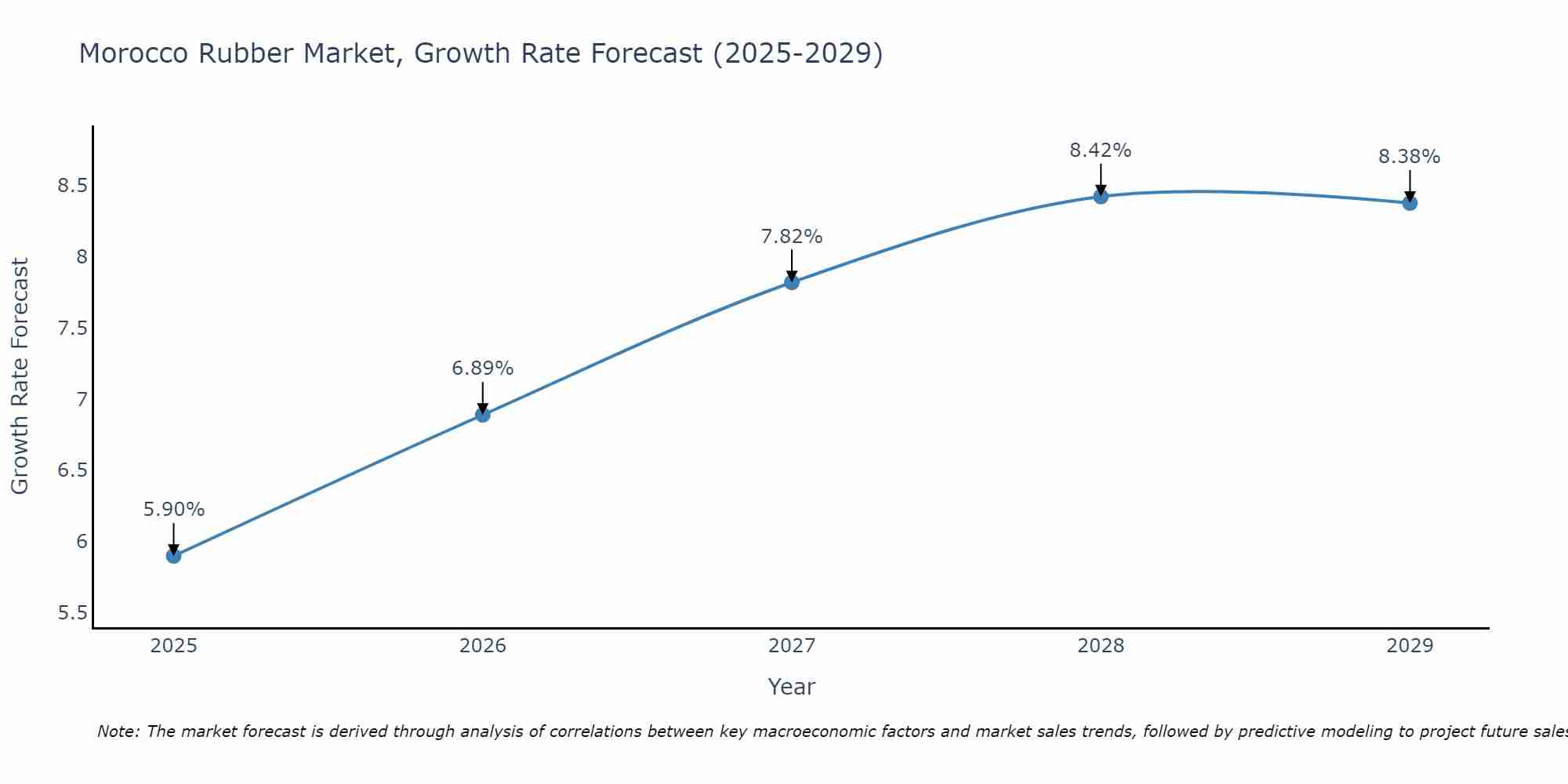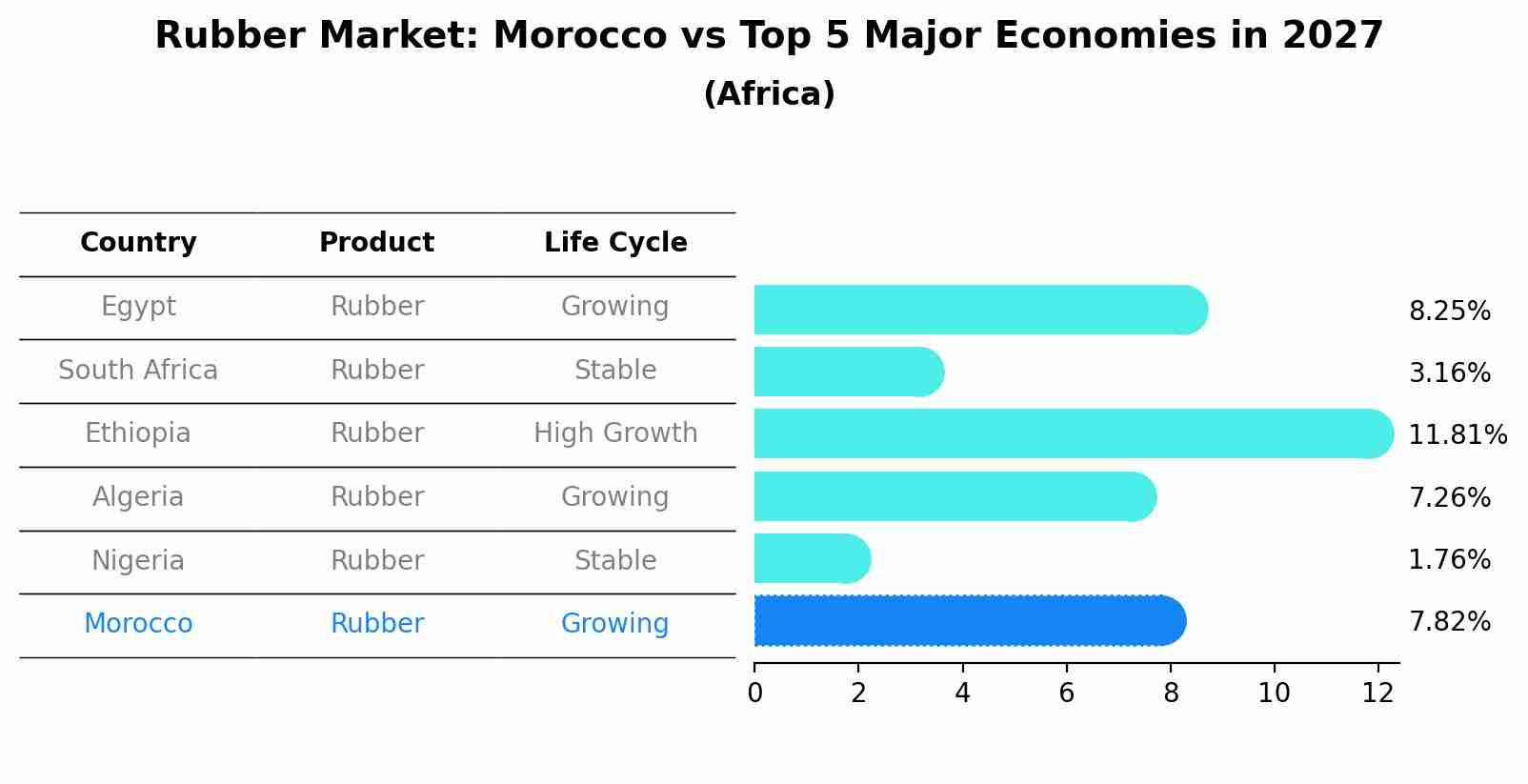Morocco Rubber Market | Value, Outlook, Companies, Forecast, Analysis, Revenue, Industry, Growth, Size, Share, COVID-19 IMPACT & Trends
| Product Code: ETC172452 | Publication Date: Jan 2022 | Updated Date: Jun 2025 | Product Type: Market Research Report | |
| Publisher: 6Wresearch | Author: Summon Dutta | No. of Pages: 70 | No. of Figures: 35 | No. of Tables: 5 |
Morocco Rubber Market Size Growth Rate
The Morocco Rubber Market is projected to witness mixed growth rate patterns during 2025 to 2029. Growth accelerates to 8.42% in 2028, following an initial rate of 5.90%, before easing to 8.38% at the end of the period.

Rubber Market: Morocco vs Top 5 Major Economies in 2027 (Africa)
The Rubber market in Morocco is projected to grow at a growing growth rate of 7.82% by 2027, within the Africa region led by Egypt, along with other countries like South Africa, Ethiopia, Algeria and Nigeria, collectively shaping a dynamic and evolving market environment driven by innovation and increasing adoption of emerging technologies.

Morocco Rubber Market Overview
The Morocco rubber market is experiencing steady growth due to the increasing demand from various industries such as automotive, construction, and consumer goods. The country`s rubber market is primarily driven by the rising investments in infrastructure projects, leading to higher demand for rubber products like tires, hoses, and conveyor belts. The government`s focus on promoting industrial development and attracting foreign investments has also contributed to the market`s expansion. Additionally, the growing awareness of the benefits of using rubber products in terms of durability and performance has further fueled the market growth. However, challenges such as fluctuating raw material prices and competition from international players remain key factors affecting the Morocco rubber market`s dynamics.
Morocco Rubber Market Trends
The rubber market in Morocco is witnessing a growing demand due to the country`s expanding automotive and construction industries. The market is experiencing a trend towards sustainability, with an increasing emphasis on eco-friendly and recyclable rubber products. There is also a growing interest in innovation and technology, leading to the development of new rubber compounds and applications. Additionally, the market is seeing a rise in partnerships and collaborations between local manufacturers and global players to enhance production capabilities and increase market reach. Overall, the Morocco rubber market is expected to continue its growth trajectory driven by these trends in the coming years.
Morocco Rubber Market Challenges
In the Morocco Rubber Market, challenges arise due to factors such as fluctuating raw material prices, competition from imported rubber products, and the limited local production capacity. The market can be impacted by global economic conditions and geopolitical instability, leading to uncertainty in demand and pricing. Additionally, the industry may face challenges related to technology adoption, regulatory compliance, and sustainability practices. Developing a robust supply chain, managing inventory levels efficiently, and ensuring product quality and consistency are crucial for companies operating in the Morocco Rubber Market to remain competitive and meet customer expectations amidst these challenges.
Morocco Rubber Market Investment Opportunities
The Morocco rubber market presents promising investment opportunities in the automotive industry due to the country`s growing automotive sector. With the demand for vehicles on the rise in Morocco and the African region as a whole, there is an increasing need for rubber components such as tires, hoses, and seals. Investors could consider opportunities in rubber manufacturing companies supplying the automotive sector or in establishing rubber processing plants to cater to this growing demand. Additionally, there is potential for investment in sustainable rubber production practices to meet the increasing consumer demand for environmentally friendly products. Overall, the Morocco rubber market offers potential for growth and profitability in alignment with the expanding automotive industry in the region.
Morocco Rubber Market Government Policy
The Moroccan government has implemented various policies to support the rubber market in the country. These policies include providing financial incentives and support to rubber producers, promoting research and development in the sector, and encouraging investment in rubber cultivation and processing facilities. Additionally, the government has established regulations to ensure quality standards are met in the production and processing of rubber products. The Moroccan government aims to boost the competitiveness of the rubber market domestically and internationally through these policies, ultimately driving growth and sustainability in the sector.
Morocco Rubber Market Future Outlook
The future outlook for the Morocco Rubber Market appears promising as the country`s automotive and construction industries continue to grow, driving the demand for rubber products. Additionally, Morocco`s favorable investment climate and government initiatives to promote industrial development are expected to attract more foreign investments in the rubber sector. The increasing focus on sustainable and eco-friendly products is also likely to drive innovation in the rubber market, with a shift towards the production of bio-based and recycled rubber materials. However, challenges such as fluctuating raw material prices and competition from other global markets may impact the growth of the Morocco Rubber Market. Overall, with the right strategies and investments in place, the market is poised for steady growth in the coming years.
Key Highlights of the Report:
- Morocco Rubber Market Outlook
- Market Size of Morocco Rubber Market, 2021
- Forecast of Morocco Rubber Market, 2031
- Historical Data and Forecast of Morocco Rubber Revenues & Volume for the Period 2018 - 2031
- Morocco Rubber Market Trend Evolution
- Morocco Rubber Market Drivers and Challenges
- Morocco Rubber Price Trends
- Morocco Rubber Porter's Five Forces
- Morocco Rubber Industry Life Cycle
- Historical Data and Forecast of Morocco Rubber Market Revenues & Volume By Type for the Period 2018 - 2031
- Historical Data and Forecast of Morocco Rubber Market Revenues & Volume By Natural for the Period 2018 - 2031
- Historical Data and Forecast of Morocco Rubber Market Revenues & Volume By Synthetic for the Period 2018 - 2031
- Historical Data and Forecast of Morocco Rubber Market Revenues & Volume By Application for the Period 2018 - 2031
- Historical Data and Forecast of Morocco Rubber Market Revenues & Volume By Tire for the Period 2018 - 2031
- Historical Data and Forecast of Morocco Rubber Market Revenues & Volume By Non-Tire Automotive for the Period 2018 - 2031
- Historical Data and Forecast of Morocco Rubber Market Revenues & Volume By Footwear for the Period 2018 - 2031
- Historical Data and Forecast of Morocco Rubber Market Revenues & Volume By Industrial Goods for the Period 2018 - 2031
- Historical Data and Forecast of Morocco Rubber Market Revenues & Volume By Others for the Period 2018 - 2031
- Morocco Rubber Import Export Trade Statistics
- Market Opportunity Assessment By Type
- Market Opportunity Assessment By Application
- Morocco Rubber Top Companies Market Share
- Morocco Rubber Competitive Benchmarking By Technical and Operational Parameters
- Morocco Rubber Company Profiles
- Morocco Rubber Key Strategic Recommendations
Frequently Asked Questions About the Market Study (FAQs):
1 Executive Summary |
2 Introduction |
2.1 Key Highlights of the Report |
2.2 Report Description |
2.3 Market Scope & Segmentation |
2.4 Research Methodology |
2.5 Assumptions |
3 Morocco Rubber Market Overview |
3.1 Morocco Country Macro Economic Indicators |
3.2 Morocco Rubber Market Revenues & Volume, 2021 & 2031F |
3.3 Morocco Rubber Market - Industry Life Cycle |
3.4 Morocco Rubber Market - Porter's Five Forces |
3.5 Morocco Rubber Market Revenues & Volume Share, By Type, 2021 & 2031F |
3.6 Morocco Rubber Market Revenues & Volume Share, By Application, 2021 & 2031F |
4 Morocco Rubber Market Dynamics |
4.1 Impact Analysis |
4.2 Market Drivers |
4.3 Market Restraints |
5 Morocco Rubber Market Trends |
6 Morocco Rubber Market, By Types |
6.1 Morocco Rubber Market, By Type |
6.1.1 Overview and Analysis |
6.1.2 Morocco Rubber Market Revenues & Volume, By Type, 2021-2031F |
6.1.3 Morocco Rubber Market Revenues & Volume, By Natural, 2021-2031F |
6.1.4 Morocco Rubber Market Revenues & Volume, By Synthetic, 2021-2031F |
6.2 Morocco Rubber Market, By Application |
6.2.1 Overview and Analysis |
6.2.2 Morocco Rubber Market Revenues & Volume, By Tire, 2021-2031F |
6.2.3 Morocco Rubber Market Revenues & Volume, By Non-Tire Automotive, 2021-2031F |
6.2.4 Morocco Rubber Market Revenues & Volume, By Footwear, 2021-2031F |
6.2.5 Morocco Rubber Market Revenues & Volume, By Industrial Goods, 2021-2031F |
6.2.6 Morocco Rubber Market Revenues & Volume, By Others, 2021-2031F |
7 Morocco Rubber Market Import-Export Trade Statistics |
7.1 Morocco Rubber Market Export to Major Countries |
7.2 Morocco Rubber Market Imports from Major Countries |
8 Morocco Rubber Market Key Performance Indicators |
9 Morocco Rubber Market - Opportunity Assessment |
9.1 Morocco Rubber Market Opportunity Assessment, By Type, 2021 & 2031F |
9.2 Morocco Rubber Market Opportunity Assessment, By Application, 2021 & 2031F |
10 Morocco Rubber Market - Competitive Landscape |
10.1 Morocco Rubber Market Revenue Share, By Companies, 2021 |
10.2 Morocco Rubber Market Competitive Benchmarking, By Operating and Technical Parameters |
11 Company Profiles |
12 Recommendations |
13 Disclaimer |
- Single User License$ 1,995
- Department License$ 2,400
- Site License$ 3,120
- Global License$ 3,795
Search
Thought Leadership and Analyst Meet
Our Clients
Related Reports
- Germany Breakfast Food Market (2026-2032) | Industry, Share, Growth, Size, Companies, Value, Analysis, Revenue, Trends, Forecast & Outlook
- Australia Briquette Market (2025-2031) | Growth, Size, Revenue, Forecast, Analysis, Trends, Value, Share, Industry & Companies
- Vietnam System Integrator Market (2025-2031) | Size, Companies, Analysis, Industry, Value, Forecast, Growth, Trends, Revenue & Share
- ASEAN and Thailand Brain Health Supplements Market (2025-2031) | Strategy, Consumer Insights, Analysis, Investment Trends, Opportunities, Growth, Size, Share, Industry, Revenue, Segments, Value, Segmentation, Supply, Forecast, Restraints, Outlook, Competition, Drivers, Trends, Demand, Pricing Analysis, Competitive, Strategic Insights, Companies, Challenges
- ASEAN Bearings Market (2025-2031) | Strategy, Consumer Insights, Analysis, Investment Trends, Opportunities, Growth, Size, Share, Industry, Revenue, Segments, Value, Segmentation, Supply, Forecast, Restraints, Outlook, Competition, Drivers, Trends, Demand, Pricing Analysis, Competitive, Strategic Insights, Companies, Challenges
- Europe Flooring Market (2025-2031) | Outlook, Share, Industry, Trends, Forecast, Companies, Revenue, Size, Analysis, Growth & Value
- Saudi Arabia Manlift Market (2025-2031) | Outlook, Size, Growth, Trends, Companies, Industry, Revenue, Value, Share, Forecast & Analysis
- Uganda Excavator, Crane, and Wheel Loaders Market (2025-2031) | Strategy, Consumer Insights, Analysis, Investment Trends, Opportunities, Growth, Size, Share, Industry, Revenue, Segments, Value, Segmentation, Supply, Forecast, Restraints, Outlook, Competition, Drivers, Trends, Demand, Pricing Analysis, Competitive, Strategic Insights, Companies, Challenges
- Rwanda Excavator, Crane, and Wheel Loaders Market (2025-2031) | Strategy, Consumer Insights, Analysis, Investment Trends, Opportunities, Growth, Size, Share, Industry, Revenue, Segments, Value, Segmentation, Supply, Forecast, Restraints, Outlook, Competition, Drivers, Trends, Demand, Pricing Analysis, Competitive, Strategic Insights, Companies, Challenges
- Kenya Excavator, Crane, and Wheel Loaders Market (2025-2031) | Strategy, Consumer Insights, Analysis, Investment Trends, Opportunities, Growth, Size, Share, Industry, Revenue, Segments, Value, Segmentation, Supply, Forecast, Restraints, Outlook, Competition, Drivers, Trends, Demand, Pricing Analysis, Competitive, Strategic Insights, Companies, Challenges
Industry Events and Analyst Meet
Whitepaper
- Middle East & Africa Commercial Security Market Click here to view more.
- Middle East & Africa Fire Safety Systems & Equipment Market Click here to view more.
- GCC Drone Market Click here to view more.
- Middle East Lighting Fixture Market Click here to view more.
- GCC Physical & Perimeter Security Market Click here to view more.
6WResearch In News
- Doha a strategic location for EV manufacturing hub: IPA Qatar
- Demand for luxury TVs surging in the GCC, says Samsung
- Empowering Growth: The Thriving Journey of Bangladesh’s Cable Industry
- Demand for luxury TVs surging in the GCC, says Samsung
- Video call with a traditional healer? Once unthinkable, it’s now common in South Africa
- Intelligent Buildings To Smooth GCC’s Path To Net Zero


















